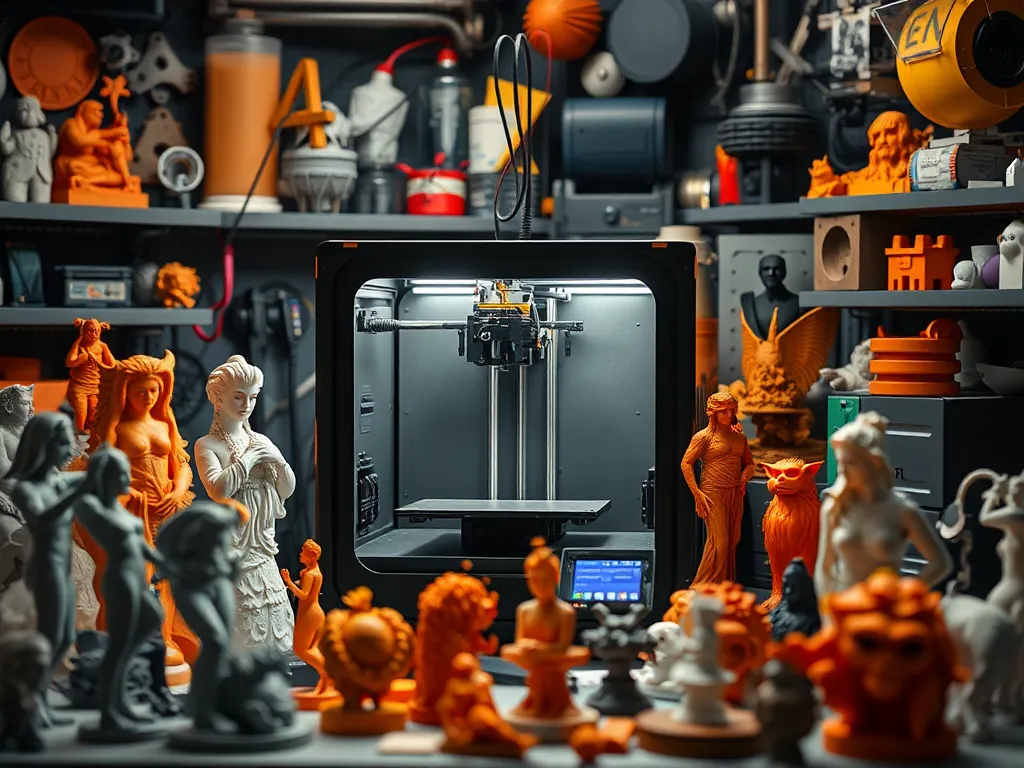Anycubic 3D Printer: A Comprehensive Guide

Anycubic 3D Printer: A Comprehensive Guide
In recent years, 3D printing has revolutionized the manufacturing industry, allowing individuals and businesses to create custom objects with ease. One of the leading brands in the 3D printing market is Anycubic. Known for its high-quality printers and affordable prices, Anycubic has gained a strong reputation among hobbyists, professionals, and educators. In this article, we will explore everything you need to know about Anycubic 3D printers, including their features, setup and installation process, printing techniques, troubleshooting, advanced techniques, and various applications.
If you're on the lookout for an exceptional anycubic 3d printer , now is the perfect time to delve into the world of 3D printing. The Anycubic Kobra 2 Pro stands out among its competitors in bringing practical features along with high-quality print results.
Introduction to Anycubic 3D Printer
Embrace the cutting-edge advantages that an anycubic 3d printer paired with advanced printing technology can bring. Don't wander too far; here's a comprehensive review of the Anycubic Kobra 2 Pro , a product that certainly enhances the 3D printing experience.
Before diving into the details, let's understand what an Anycubic 3D printer is. Simply put, it is a device that can create three-dimensional objects by depositing layers of material on top of each other. It uses a process called additive manufacturing, where a digital model is sliced into thin layers and then printed layer by layer. Anycubic printers utilize various materials such as PLA, ABS, PETG, and TPU to create durable and intricate objects.
Benefits of Using Anycubic 3D Printer
There are several advantages to using an Anycubic 3D printer. Firstly, it provides the freedom to manufacture customized objects according to specific requirements. This is particularly beneficial for prototyping and product development. Secondly, Anycubic printers are user-friendly, making them suitable for beginners and experienced users alike. They come pre-assembled or require minimal assembly, making the setup process hassle-free. Additionally, Anycubic printers are known for their high-resolution prints and precise details, ensuring excellent print quality.
Key Features of Anycubic 3D Printers
Anycubic 3D printers are designed with several key features that make them stand out in the market. These include:
- Large Build Volume: Anycubic printers offer a spacious build volume, allowing users to create objects of varying sizes. - High Precision Printing: With a high-resolution printing capability, Anycubic printers produce detailed and accurate prints. - Auto-Leveling: Many Anycubic models have a built-in auto-leveling feature, ensuring a level print bed and reducing the need for manual adjustments. - Touchscreen Interface: The printers come with an intuitive touchscreen interface, making them easy to operate and navigate through settings. - Filament Detection: Some Anycubic printers have filament detection sensors that pause the printing process when the filament runs out or gets jammed. - Dual Extrusion: Certain Anycubic models support dual extrusion, enabling printing with multiple colors or materials.
Anycubic 3D Printer Models and Specifications
Anycubic offers a range of 3D printers to suit different needs and budgets. Some popular models include the Anycubic Mega-S, Anycubic Photon Mono X, and Anycubic Chiron. These printers have varying build volumes, layer resolutions, and compatibility with different filaments. It is important to review the specifications of each model to choose the one that best fits your requirements.
Setup and Installation of Anycubic 3D Printer
Setting up an Anycubic 3D printer is a straightforward process. Here are the steps involved:
- Unbox the printer and check if all the components are present. - Assemble the printer following the provided instructions. Most Anycubic printers come partially assembled, reducing the setup time. - Calibrate the printer by leveling the print bed. This ensures the nozzle is at the correct height for proper printing. - Install the required software and drivers on your computer. Anycubic provides user-friendly software compatible with both Windows and Mac. - Connect the printer to your computer or network using the provided USB cable or Wi-Fi module. This allows you to send the print files to the printer for printing.
Setting the stage for leading-edge 3D printing capabilities, the Anycubic 3D printer is a coveted piece of machinery, particularly for enthusiasts and professionals alike. Proceed to https://dearadamsmith.com/uncategorized/anycubic-kobra-2-pro-review/ and usher your creativity into the 3-dimensional world.
Printing with Anycubic 3D Printer
Frame your ideas into tangible realities swiftly and efficiently, courtesy of Anycubic 3D printing solutions . Find out what makes it the top choice among 3D printing enthusiasts through this detailed Anycubic Kobra 2 Pro review .
Once the setup is complete, you are ready to start printing with your Anycubic 3D printer. Here is a step-by-step guide for printing:
Preparing the 3D Model for Printing
- Choose or create a 3D model using computer-aided design (CAD) software or download ready-made models from online repositories. - Import the 3D model into the Anycubic software and position it on the virtual print bed. - Scale, rotate, or resize the model according to your preferences.
Choosing the Right Filament
- Select the appropriate filament type based on your desired outcome and object specifications. PLA filament is commonly used for its ease of use and versatility, while ABS filament offers greater strength and durability. There are also specialty filaments available for specific applications, such as flexible TPU filament for creating objects with flexible properties.
Adjusting the Printer Settings
- In the Anycubic software, choose the desired printing parameters, such as layer height, print speed, and infill density. - Fine-tune the printer settings based on the complexity of the object and the desired print quality.
Starting and Monitoring the Printing Process
- Transfer the print file from the computer to the printer using a USB cable or Wi-Fi connection. - Start the printing process and monitor the progress. - Ensure the printer is operating smoothly and make any necessary adjustments if issues arise.
Post-Processing and Finishing Techniques
- Once the printing is complete, carefully remove the object from the print bed. Use a spatula or scraper to gently detach it. - Clean the printed object to remove any support structures or imperfections. - Apply post-processing techniques such as sanding, polishing, painting, or gluing parts together for assembly.
Troubleshooting and Maintenance
While Anycubic 3D printers are generally reliable, occasional troubleshooting and maintenance may be required. Here are some common issues and their solutions:
Grasp the innovation and prowess of 3D printing with the Anycubic range . Manifest your designs into the physical plane and equip yourself with an impartial review of the varied capabilities of the Kobra 2 Pro .
- Print Bed Adhesion Problems: Ensure the print bed is clean and level. Apply adhesive such as glue stick, tape, or special 3D printing bed adhesives if needed. - Extrusion Issues: Check if the filament is properly loaded and not tangled. Clean or replace the nozzle if clogged. - Print Quality Problems: Adjust the printing parameters, such as temperature and speed, to improve print quality. - Software Errors: Update the software and firmware regularly to benefit from bug fixes and improvements.
Discover the world of Anycubic’s 3D printer portfolio offering unmatched precision and utility in every model. Dig into an insightful review of the Anycubic Kobra 2 Pro and uncover its advantages in an ever-evolving industry.
Cleaning and Maintenance Tips
- Regularly clean the print bed and remove any adhesive residue. - Keep the printer in a clean and dust-free environment. - Lubricate the moving parts, such as rods and belts, according to the manufacturer's recommendations. - Clean or replace the print nozzle periodically to prevent clogs.
Updating Firmware and Software
- Check for firmware and software updates on the Anycubic website. - Download the latest files and follow the instructions provided to update the firmware and software on your printer.
Replacing Parts and Consumables
- If any components or parts are damaged or worn out, refer to the Anycubic user manual or website for replacement options. - Regularly replace consumables such as filaments, nozzles, and build surfaces for optimal printing results.
Advanced Techniques with Anycubic 3D Printer
Once you are familiar with the basics of Anycubic 3D printing, you can explore advanced techniques to enhance your printing capabilities. Here are some suggestions:
- Using Different Types of Filaments: Experiment with specialty filaments like wood-infused PLA or metal-infused PLA to add unique textures to your prints. - Experimenting with Advanced Printing Settings: Fine-tune parameters such as layer height, temperature, and print speed to achieve specific aesthetic or functional effects. - Creating Complex and Intricate Designs: Push the limits of your creativity by designing and printing complex shapes, structures, and detailed models. - Multi-Color and Multi-Material Printing: Explore dual extrusion and multi-material techniques to create objects with multiple colors or using dissolvable support materials. - Upgrading and Modifying the Anycubic 3D Printer: Customize your printer with upgrades such as silent stepper motor drivers, enhanced cooling systems, or a larger build volume.
Applications of Anycubic 3D Printer
Anycubic 3D printers find applications in various fields. Some common uses include:
- Prototyping and Product Development: 3D printing allows rapid prototyping and iterative design improvements, reducing the time and cost associated with traditional manufacturing methods. - Art and Sculpture: Artists and sculptors utilize 3D printing to bring their digital creations into the physical world, enabling them to experiment with new mediums and forms. - Educational Purposes: Anycubic printers are valuable tools in educational settings, teaching students about design, engineering, and problem-solving. They allow students to transform their ideas into tangible objects. - Engineering and Architectural Models: Architects and engineers use 3D printers to create physical models of their designs, aiding in visualization and communication. - Medical and Healthcare Applications: 3D printing is revolutionizing the medical field by enabling the production of customized prosthetics, anatomical models, and surgical guides.
In conclusion, Anycubic 3D printers are reliable, user-friendly, and versatile tools for creating three-dimensional objects. Whether for personal use, professional applications, or educational purposes, Anycubic printers offer a wide range of features and capabilities. By understanding the setup process, printing techniques, troubleshooting, and advanced techniques, users can maximize the potential of their Anycubic 3D printer and explore endless possibilities in the world of additive manufacturing.
